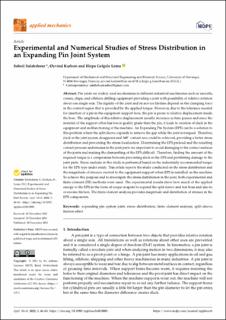| dc.contributor.author | Salahshour Langeroodi, Soheil | |
| dc.contributor.author | Karlsen, Øyvind | |
| dc.contributor.author | Lemu, Hirpa G. | |
| dc.date.accessioned | 2023-03-16T11:31:56Z | |
| dc.date.available | 2023-03-16T11:31:56Z | |
| dc.date.created | 2023-01-19T21:16:33Z | |
| dc.date.issued | 2022 | |
| dc.identifier.citation | Salahshour, S., Karlsen, Ø., & Lemu, H. G. (2021). Experimental and numerical studies of stress distribution in an Expanding Pin Joint System. Applied Mechanics, 3(1), 46-63. | en_US |
| dc.identifier.uri | https://hdl.handle.net/11250/3058729 | |
| dc.description.abstract | Pin joints are widely used mechanisms in different industrial machineries such as aircrafts, cranes, ships, and offshore drilling equipment providing a joint with possibility of relative rotation about one single axis. The rigidity of the joint and its service lifetime depend on the clamping force in the contact region that is provided by the applied torque. However, due to the tolerance needed for insertion of a pin in the equipment support bore, the pin is prone to relative displacement inside the bore. The amplitude of this relative displacement usually increases as time passes and since the material of the support often has lower quality grade than the pin, it leads to creation of slack in the equipment and malfunctioning of the machine. An Expanding Pin System (EPS) can be a solution to this problem where the split sleeve expands to remove the gap while the joint is torqued. Therefore, slack in the joint system disappears and 360° contact area could be achieved, providing a better stress distribution and preventing the stress localization. Determining the EPS preload and the resulting contact pressure and stresses in the joint parts are important to avoid damaging to the contact surfaces of the joints and making the dismantling of the EPS difficult. Therefore, finding the amount of the required torque is a compromise between preventing slack in the EPS and prohibiting damage to the joint parts. Stress analysis in this study is performed based on the industrially recommended torque for the EPS type under study. This article reports the study conducted on the stress distribution and the magnitude of stresses exerted to the equipment support when EPS is installed on the machine. To achieve this purpose and to investigate the stress distribution in the joint, both experimental and finite element (FE) methods were used. The experimental results show how much of the applied energy to the EPS in the form of torque is spent to expand the split sleeve and test boss and also to overcome friction. The finite element analysis provides magnitude and distribution of stresses in the EPS components. | en_US |
| dc.language.iso | eng | en_US |
| dc.publisher | MDPI | en_US |
| dc.rights | Navngivelse 4.0 Internasjonal | * |
| dc.rights.uri | http://creativecommons.org/licenses/by/4.0/deed.no | * |
| dc.title | Experimental and Numerical Studies of Stress Distribution in an Expanding Pin Joint System | en_US |
| dc.type | Peer reviewed | en_US |
| dc.type | Journal article | en_US |
| dc.description.version | publishedVersion | en_US |
| dc.rights.holder | The authors | en_US |
| dc.subject.nsi | VDP::Teknologi: 500 | en_US |
| dc.source.pagenumber | 46-63 | en_US |
| dc.source.volume | 3 | en_US |
| dc.source.journal | Applied Mechanics | en_US |
| dc.source.issue | 1 | en_US |
| dc.identifier.doi | 10.3390/applmech3010003 | |
| dc.identifier.cristin | 2110939 | |
| cristin.ispublished | true | |
| cristin.fulltext | original | |
| cristin.qualitycode | 1 | |

